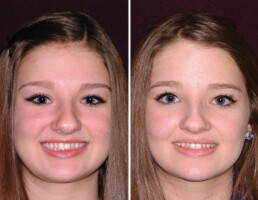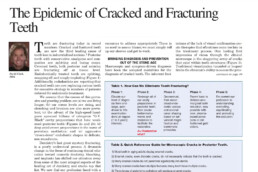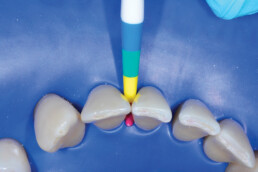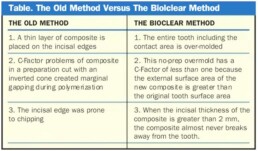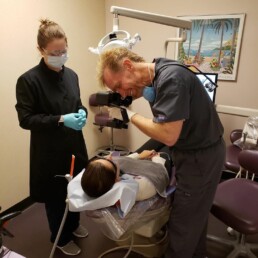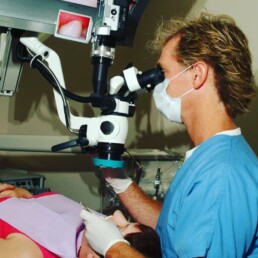Orthodontics for Undersized Teeth
Bioclear Injection Over-Molding versus traditional dental “Bonding” ... “Bonding” sounds like a cheap way to fix a wrecked car fender. This has given dental composites a bad name. Online “Cosmetic Dentistry Experts” tell consumers that bonding is inferior to porcelain veneers. Flawed systems, lack of training, and a dearth of proper composite engineering principles eventually cause teeth to look like poor asphalt patchwork. The Bioclear approach is not bonding. It is injection overmolding. Instead of just patching the tooth, the Bioclear Matrix and method allows the entire tooth to be overmolded with variable thickness composite. Properly done, the Bioclear matrix and method is superior to porcelain veneers for young post-ortho patients to complete injection overmold cases with undersized incisors.
Cracked & Fracturing Teeth
“Teeth are fracturing in record numbers. Cracked and fractured teeth are now the 3rd leading cause of tooth loss in industrialized nations. Posterior teeth with conservative amalgams and com-posites are splitting and losing cusps. Crowned teeth, both posterior and anterior, are fracturing off at tissue level. Endodontically treated teeth are splitting, snapping off, and simply imploding. Additionally, endodontists are reporting that cracked teeth are now replacing carious teeth for causative etiology in numbers of patients referred for endodontic treatment.
We assume that the causes of this pervasive and growing problem are (a) we are living longer; (b) our stress levels are rising, and clenching and bruxism are also more prevalent; (c) the advent of the high-speed handpiece spawned billions of iatrogenic “G.V. Black” cavity preparations that have weakened posterior teeth deep axial crown preparations in the name of porcelain aesthetics; and (e) aggressive “crown-down” endodontic shapes in delicate, non-round roots.
Dentistry’s last great mystery, fracturing, is a poorly understood process. A dramatic change in the focus of continuing dental education toward cosmetic dentistry, bleaching, and implants has shifted our attention away from some of the most integral aspects of the healing art of dentistry, and cracks top that list. We now find our profession faced with a monumental problem that will require a significant commitment and reallocation of resources to address appropriately. There is no need to assess blame; we must simply roll up our sleeves and get to work.”
The Mother of All Black Triangles
"Sometimes a particular case comes along that appears, at first, to be overwhelming. The case described in this article fits that description. However, when this patient emailed my office and inquired about the possibility of flying across the country to have me treat him, I had fortunately done many cases involving hundreds of teeth using the matrix system that I developed to treat dentition afflicted with black triangles, albeit none of this magnitude. I felt absolutely confident that we could achieve a good outcome. The trick was to disassemble the case into bite-sized pieces. This case presents many excellent questions and the additional challenge of severe facial abrasions. I will first review the background of black triangles and of lower incisor complications, and then proceed with the presentation of the clinical procedures used to treat this particular patient."
Treating the Dreaded Black Triangle
This case presents many excellent questions and the additional challenge of severe facial abrasions. First Cosmetic Dentist Dr David Clark reviews the background of black triangle gaps between teeth and of lower incisor complications and then proceed with the presentation of the clinical procedures used to treat this particular patient.
Treating Severely Worn Lower Incisors
Older dental patients present unique challenges that require dentists to turn to innovative treatment solutions. Each patient treatment should be based on a multitude of factors. However, in the end, two simple questions should be posed to every patient who has reached the twilight of their life, defy the odds, and live on, and on, and on. First, do you think that you will live or could live another 5 or 10 years? Second, do want to outlast your teeth or would you like your teeth to outlast you?
The New Science of Strong Teeth
Most restorative dentists - here in Tacoma and elsewhere - have questioned themselves in regards to the way they prepare Class II restorations. I have certainly done so as my 57-carbide mowed through mostly healthy tooth structure, knowing that I was seriously weakening the tooth.
Microscopes for Esthetic Dentistry
One of America’s best-known architects, Frank Lloyd Wright, once said, “The physician can bury his mistakes, but the architect can only advise his clients to plant vines.” Recent dramatic changes in the practice of both restorative and cosmetic dentistry have placed us in a position that is now very similar to Wright’s architect. Dental patients now “grade” their dentists on the aesthetic quality of their results, and the bar goes ever higher.
Patient Centered Outcomes
Renowned cosmetic dentist Dr. David J. Clark, DDS, defines patient-centered outcomes vs process outcomes and promotes a more minimally invasive mindset in the profession that favors preservation and restoration of the natural tooth.
Optimizing Gingival Esthetics
As patients become increasingly aware of the esthetic potential through cosmetic dentistry, there is an increasing demand for smile makeovers with porcelain. In our efforts to create beautiful smiles, we tend to focus on tooth color, shape, proportion and alignment as we are bombarded with restorative choices.
Microscopes & Zero-Defect Dentistry
Initially resisted by endodontists and mainstream dentists, there has been a recent surge of interest in microscope-enhanced dentistry. In endodontics, the microscope is becoming standard equipment. At a recent opinion leader’s forum, the question was posed: “Should microscopes be required for all endodontic treatment?” This incredible swing in endodontic opinion also is being felt in general dentistry.
